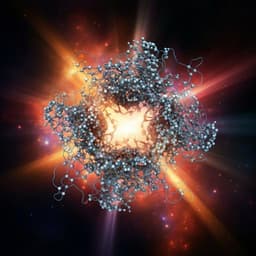
Chemistry
Iridium-catalyzed enantioselective synthesis of chiral γ-amino alcohols and intermediates of (S)-duloxetine, (R)-fluoxetine, and (R)-atomoxetine
C. Liu, L. Zhang, et al.
Discover how researchers Chengyu Liu and colleagues have designed innovative tridentate ferrocene-based phosphine ligands that enable iridium-catalyzed asymmetric hydrogenation of β-amino ketones, creating a pathway for the industrial production of valuable chiral γ-amino alcohols, including (S)-duloxetine and (R)-fluoxetine.
~3 min • Beginner • English
Introduction
The study targets efficient, enantioselective synthesis of chiral γ-amino alcohols—key intermediates in pharmaceuticals including (S)-duloxetine, (R)-fluoxetine, and (R)-atomoxetine. While multiple strategies exist (e.g., SN2 of γ-leaving-group alcohols with amines, Ru-catalyzed hydroamination, Michael addition followed by asymmetric transfer hydrogenation), direct asymmetric hydrogenation of β-amino ketones is particularly attractive for atom economy and environmental compatibility. However, existing systems often require high catalyst loadings, have limited substrate scope, compromised stability, and sometimes lower enantioselectivity, especially with challenging heteroaromatic substrates. This work proposes Ir catalysts bearing new tridentate ferrocene-based phosphine ligands with unsymmetrical vicinal diamines to overcome these challenges, aiming for broad scope, high activity and selectivity, and scalability to industrially relevant intermediates.
Literature Review
Prior art has extensively examined Ru- and Rh-phosphine catalysts for asymmetric hydrogenation of β-amino ketones. Achiwa’s (2S,4S)-MCCPM-Rh enabled (R)-fluoxetine synthesis (90.8% ee, S/C 1000) but gave only 79.8% ee for a related substrate (1991). Noyori’s [RuCl2(diphosphine)(1,2-diamine)] catalysts delivered efficient asymmetric synthesis of γ-tertiary amino alcohols (2000–2002). Zhang’s Rh-duanphos enabled β-secondary-amino ketone hydrogenation (90–93% yields, 93–99% ee, up to TON 4500, 2005); subsequent RuPHOX-Ru and P-chiral Rh-bisphosphine systems improved outcomes but still faced issues of catalyst loading, stability, substrate scope, and time (2013–2015). Ir catalysts have excelled broadly in asymmetric hydrogenation of C=C, C–O, and C–N functionalities, with notable advances such as SpiroPAP-Ir (high TON for simple ketones) and Ir-PNN systems based on symmetric diamines. Yet Ir-catalyzed asymmetric hydrogenation of β-amino ketones has been less explored. Unsymmetrical vicinal diamines from amino acids offer modular, tunable scaffolds potentially enabling fine-tuning of electronic and steric effects; this study leverages such ligands to develop robust Ir catalysts for broad β-amino ketone hydrogenation.
Methodology
Ligand design and preparation: A series of chiral tridentate ferrocene-based phosphine ligands (denoted (RCSCPRC)-L1–L7) bearing monosulfonyl unsymmetrical vicinal diamine scaffolds were synthesized by coupling an acetate derived from commercial (R)-Ugi’s amine with unsymmetrical vicinal diamines from chiral amino alcohols. Ligands are air-stable and easily synthesized.
Catalyst generation: Catalysts were prepared in situ by mixing [Ir(COD)Cl]2 with ligand in anhydrous iPrOH at room temperature (~25–30 °C) for 2.5 h to form an orange solution.
Model reaction and optimization: The challenging substrate N-Boc-3-(methylamino)-1-(2-thienyl)-1-propanone (1a) was used to evaluate reactivity and enantioselectivity under 30 atm H2 in the presence of base. Initial screens in iPrOH (0.4 mmol scale; 0.05 mol% [Ir(COD)Cl]2; 0.105 mol% ligand; 5 mol% base) probed ligand substituents, bases, and solvents. Ligand effects: bulky R groups on the vicinal diamine decreased ee (Me > iPr > tBu). Changing sulfonamide from p-tolyl (L1) to 2,4,6-trimethylphenyl (L6) increased ee to 97%; L5 and L7 (benzyl) gave similar outcomes (93% ee). Absolute configuration of product 2a was S by X-ray (CCDC 2116544). Base effects: NaOtBu improved ee to 98%; LiOH/NaOH gave 97% ee; KOtBu/KOH reduced ee to 93–94%; carbonates (K2CO3, Na2CO3) gave no reaction. Solvent effects: Aprotic solvents (hexane, CH2Cl2, toluene, THF) afforded >99% conversion and 98–99% ee; MeOH failed. Toluene was chosen for scope (industry-friendly).
General procedures: For N-Boc β-amino ketones 1 (S/C=1000): 100 µL of catalyst solution (0.0004 mmol Ir) was added to substrate 1 (0.4 mmol) and NaOtBu (0.02 mmol) in toluene (2.0 mL); hydrogenation at 30 atm H2 for 16 h at rt; workup by evaporation and silica gel chromatography; ee by chiral HPLC. For β-amino ketone free bases or hydrochlorides 3/3·HCl (S/C=1000): similar setup, using NaOtBu 0.02 mmol for free bases and 0.44 mmol for HCl salts; 30 atm H2; toluene (2.0 mL). For β-tertiary-amino ketones 5/5·HCl (S/C=1000): toluene (3.0 mL); 35 atm H2; NaOtBu 42.2 mg for HCl salts (5a–5p-HCl) or 1.9 mg for free bases (5q–5ad). Reaction time 16 h, rt; chromatographic purification; ee by HPLC.
Scale-up: Gram-scale hydrogenations conducted at high S/C: S/C 50,000 for 1a with Ir-(RCSCPRC)-L6; S/C 20,000 for 3g with Ir-(SCRPSC)-L6; and high S/C for 5ac with Ir-(RCSCPRC)-L6.
Stereochemical control: Both enantiomers accessible using enantiomeric ligand (RCSCPRC)-L6 or (SCRPSC)-L6.
Key Findings
- Highly efficient Ir-catalyzed asymmetric hydrogenation of diverse β-amino ketones (β-secondary- and β-tertiary-amino) to chiral γ-amino alcohols achieved up to 99% yield and >99% ee; TON up to 48,500; S/C up to 50,000 on gram scale.
- Ligand optimization identified (RCSCPRC)-L6 (2,4,6-trimethylbenzenesulfonyl) as optimal, delivering 97–99% ee under optimized conditions; absolute S configuration of 2a confirmed by X-ray.
- Base and solvent effects: NaOtBu provided best ee (up to 98% in iPrOH; 99% in toluene/hexane/CH2Cl2); LiOH/NaOH also effective (97% ee). KOtBu/KOH reduced ee; carbonates were ineffective (no reaction). Aprotic solvents favored; MeOH gave no product.
- Broad substrate scope: Heteroaromatic (thienyl, benzothienyl) and aromatic substrates reduced smoothly, generally 85–99% yields and 97–>99% ee; ortho-phenyl substrates gave slightly lower ee (e.g., 2v, 87% ee). Extended aromatics (naphthyl, fluorenyl) also high ee (96–98%) and yields (93–96%).
- Variation on amine substituents: N-Boc-3-(alkyl/benzylamino)-1-aryl ketones afforded products in 95–99% yields and 98–>99% ee; chiral α-methylbenzylamino substrate retained configuration (2am, >99:1 dr). β-Secondary- and β-tertiary-amino ketone hydrochlorides were effective, often improving stability and outcomes.
- Industrially relevant intermediates: Efficient asymmetric synthesis of γ-amino alcohol intermediates of (S)-duloxetine, (R)-fluoxetine, and (R)-atomoxetine in 86–99% yields and 96–>99% ee; both enantiomers accessible by switching ligand enantiomer.
- β-Dialkyl amino ketones: Challenging substrates (prone to elimination) hydrogenated with excellent results. Aryl β-dimethylamino ketone HCl salts with various substituents gave 88–97% yields and 96–>99% ee; fused aryl and heteroaryl substrates also high ee; furanyl example 90% yield, 93% ee.
- Functional group tolerance: Cyclic amines (pyrrolidine, piperidine, morpholine, tetrahydroisoquinoline) gave 89–97% yields and 99–>99% ee; acyclic amino groups also effective (e.g., 6p 95% yield, 98–99% ee); hydroxyl on piperidine tolerated (6q >99% ee). Piperazinyl derivatives with diverse N-substituents (cycloalkyl, benzoyl, Boc, aryl, heteroaryl, benzyl) performed well (86–99% yields, 99–>99% ee). Spirocyclic amines gave >99% ee (6z).
- Scale-up: Gram-scale reactions at high S/C maintained excellent outcomes: 1a at S/C 50,000 gave 97% yield, 99% ee; 3g at S/C 20,000 gave 92% yield, 98% ee; 5ac gave 95% yield, 99% ee.
Discussion
The study demonstrates that Ir catalysts featuring tridentate ferrocene-based phosphine ligands with unsymmetrical vicinal diamines can overcome limitations associated with prior Ru and Rh systems for β-amino ketone hydrogenation. Fine-tuning steric and electronic features via the unsymmetrical diamine and sulfonamide enabled exceptional enantioselectivity and activity across structurally diverse, often challenging substrates, including heteroaromatics (thienyl) that can poison catalysts. The system is base- and solvent-optimized, showing clear cation and solvent effects, and it tolerates a wide array of amine functionalities. The ability to process both β-secondary- and β-tertiary-amino ketones with high ee, provide both enantiomers by switching ligand chirality, and operate at very high S/C with gram-scale output directly addresses practical synthetic goals for APIs and advanced intermediates. These results significantly advance asymmetric access to γ-amino alcohols and highlight the industrial potential of the developed Ir catalysts.
Conclusion
An efficient Ir-catalyzed asymmetric hydrogenation platform using chiral tridentate ferrocene-based phosphine ligands with unsymmetrical vicinal diamines was developed for broad classes of β-amino ketones. The method affords γ-secondary- and γ-tertiary-amino alcohols in up to 99% yield and >99% ee, with TON up to 48,500, and demonstrates gram-scale viability at very high S/C. The system delivers key intermediates for (S)-duloxetine, (R)-fluoxetine, and (R)-atomoxetine, and both enantiomers are accessible by switching ligand configuration. This approach provides a robust, scalable route to valuable chiral building blocks and pharmaceuticals. Future work may expand substrate classes further, probe mechanistic details of enantioinduction with different cations/solvents, and optimize conditions for more sensitive heteroaromatic substrates.
Limitations
- Protic solvents like methanol failed to deliver product under tested conditions; iPrOH worked but aprotic solvents (toluene, CH2Cl2, hexane, THF) gave superior ee.
- Weaker bases (K2CO3, Na2CO3) gave no reaction; K+ bases (KOtBu/KOH) reduced ee compared to Li+/Na+ bases, indicating sensitivity to base/cation.
- Some substrates showed slightly diminished enantioselectivity: e.g., ortho-substituted aryl (2v, 87% ee) and a furanyl substrate (6k, 93% ee).
- Reactions require elevated hydrogen pressures (30–35 atm) and 16 h reaction times.
- The study focuses on the reported substrate sets; long-term catalyst stability and recyclability were not discussed.
Related Publications
Explore these studies to deepen your understanding of the subject.







